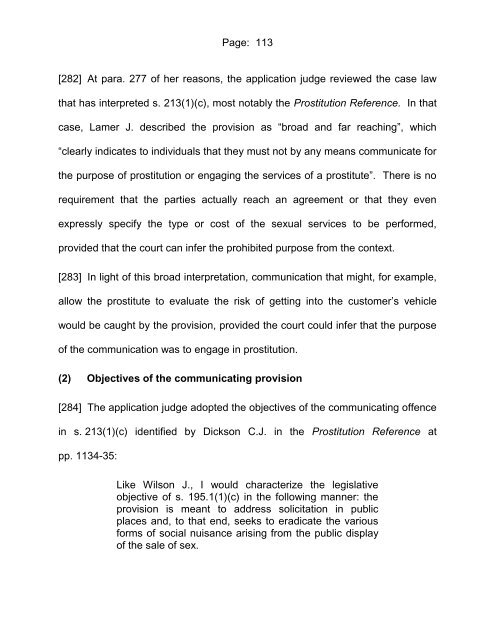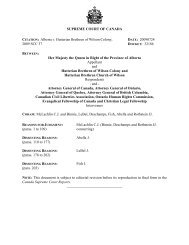Canada (Attorney General) v. Bedford, 2012 ONCA ... - York University
Canada (Attorney General) v. Bedford, 2012 ONCA ... - York University
Canada (Attorney General) v. Bedford, 2012 ONCA ... - York University
Create successful ePaper yourself
Turn your PDF publications into a flip-book with our unique Google optimized e-Paper software.
Page: 113[282] At para. 277 of her reasons, the application judge reviewed the case lawthat has interpreted s. 213(1)(c), most notably the Prostitution Reference. In thatcase, Lamer J. described the provision as “broad and far reaching”, which“clearly indicates to individuals that they must not by any means communicate forthe purpose of prostitution or engaging the services of a prostitute”. There is norequirement that the parties actually reach an agreement or that they evenexpressly specify the type or cost of the sexual services to be performed,provided that the court can infer the prohibited purpose from the context.[283] In light of this broad interpretation, communication that might, for example,allow the prostitute to evaluate the risk of getting into the customer‟s vehiclewould be caught by the provision, provided the court could infer that the purposeof the communication was to engage in prostitution.(2) Objectives of the communicating provision[284] The application judge adopted the objectives of the communicating offencein s. 213(1)(c) identified by Dickson C.J. in the Prostitution Reference atpp. 1134-35:Like Wilson J., I would characterize the legislativeobjective of s. 195.1(1)(c) in the following manner: theprovision is meant to address solicitation in publicplaces and, to that end, seeks to eradicate the variousforms of social nuisance arising from the public displayof the sale of sex.
















